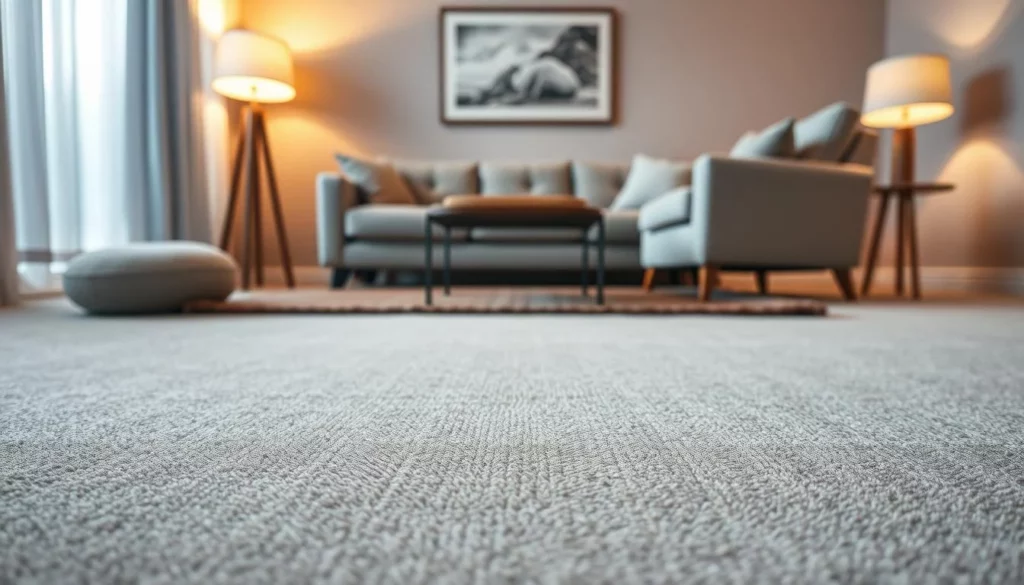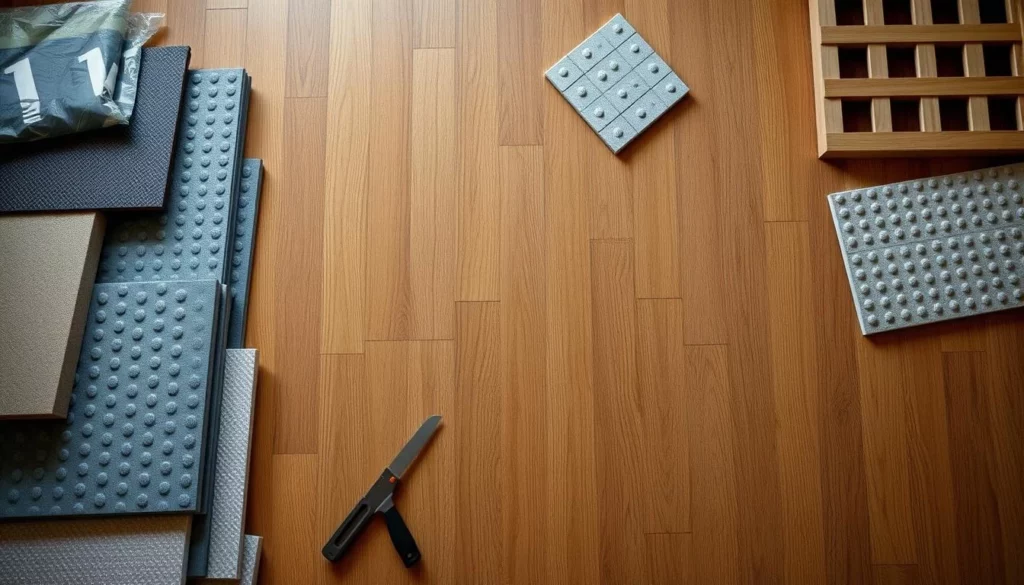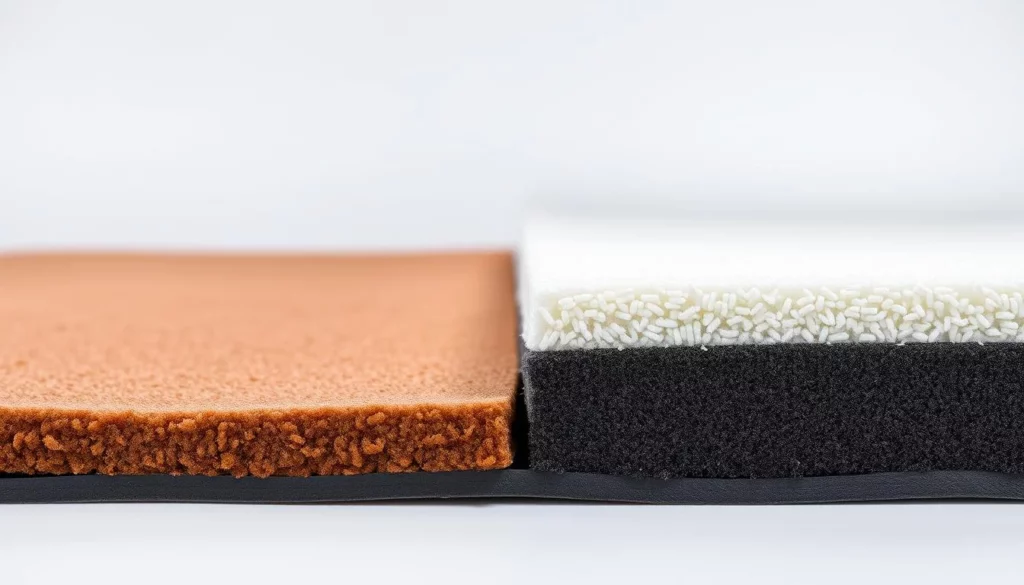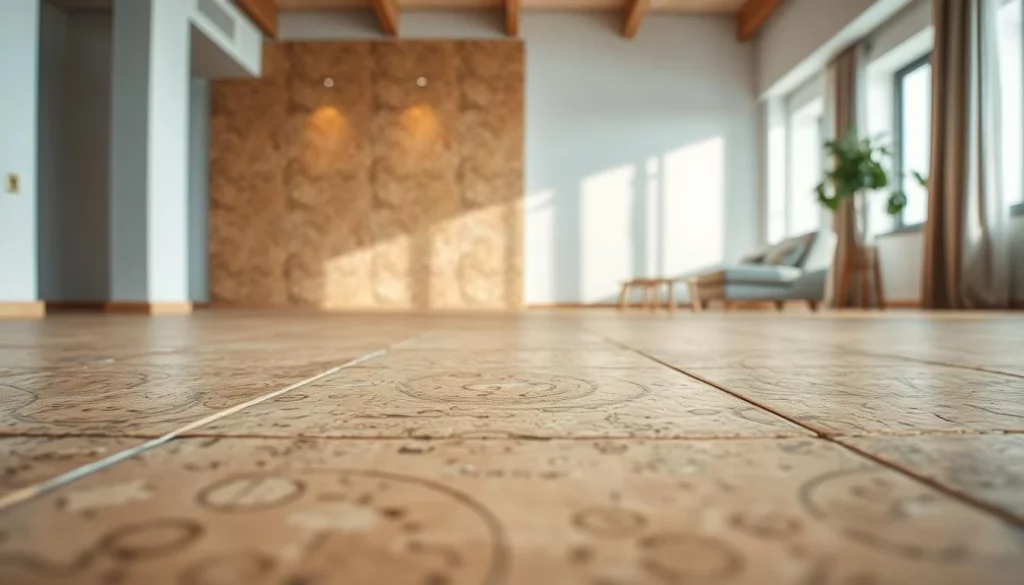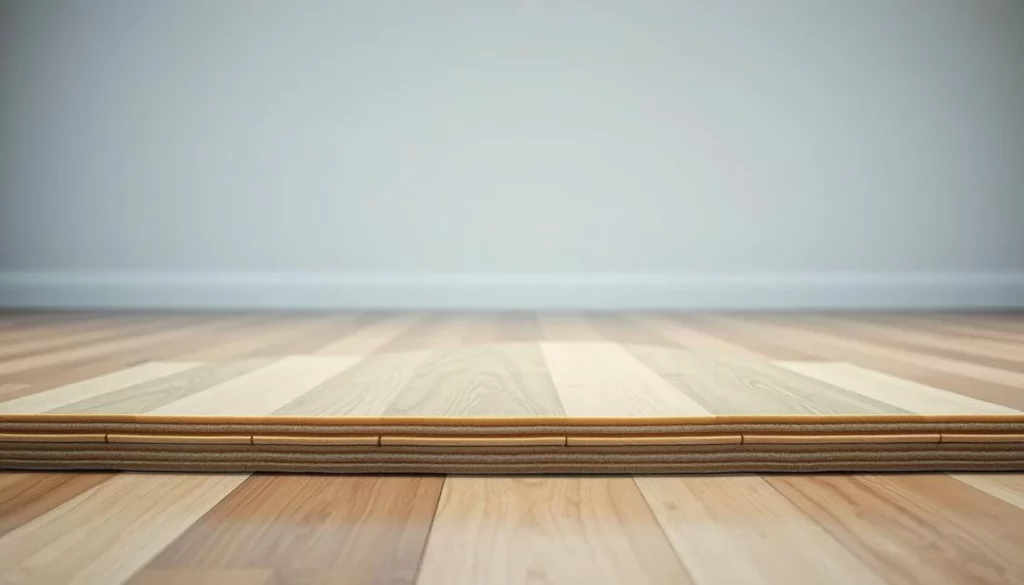You can make your home quieter by using the right noise reduction flooring. Carpets, for example, can soak up sound waves. This helps cut down on echo and noise in a room.
Did you know a carpet can cut down ambient noise by up to 35% on average? The success of carpet soundproofing depends on its thickness, density, and material. With the right underlay, you can reduce noise by 50% to 70%. By picking the right carpet and rug soundproofing options, you can change your home’s sound environment.
Understanding the Importance of Soundproofing
Soundproofing is not just a luxury; it’s essential for a peaceful home. Noise can greatly affect your life and comfort in today’s homes.
It’s important to know why soundproofing is key and the challenges it faces. Many think all carpets soundproof, but it’s not true. The thickness, density, and material of a carpet matter. Using the right soundproof underlay for carpets can boost soundproofing.
Why Soundproofing Matters in Your Home
Soundproofing improves your home life. It reduces noise, making your home a calm place for rest and work. It also cuts down on noise pollution, making your home more comfortable.
Using carpets and rugs with acoustic properties is a good way to soundproof. These materials absorb sound, lowering echo and noise.
Common Soundproofing Challenges
Soundproofing can be tough, despite its importance. Choosing the right materials is a big challenge. Not all carpets and rugs are good at soundproofing. The thickness, density, and material of a carpet affect its soundproofing ability.
| Soundproofing Material | Thickness | Density | Effectiveness |
|---|---|---|---|
| Carpet A | 1 cm | High | 8/10 |
| Carpet B | 0.5 cm | Low | 4/10 |
| Rug with Acoustic Padding | 2 cm | High | 9/10 |
The table shows how thickness and density affect soundproofing materials. So, picking materials designed for soundproofing is crucial.
Benefits of Using Carpets and Rugs for Soundproofing
Adding sound absorbing rugs and soundproofing materials to your carpets can greatly improve your home’s sound comfort. These items help cut down on echo and ambient noise. This makes your living space quieter and more peaceful.
Acoustic Absorption and Noise Reduction
Carpet and rugs are great for soundproofing because they absorb sound well. The fibers in these materials can soak up sound waves. This reduces echoes and ambient noise.
Choosing the right soundproofing materials for carpets can boost their sound-absorbing power. For example, carpets with thick piles are better at absorbing sound than those with thin piles. Area rugs can also be placed in noisy areas like hallways or living rooms to help reduce noise.
Thermal Insulation Advantages
Carpets and rugs do more than just absorb sound. They also provide thermal insulation. This means they help keep your home warm in winter and cool in summer. This can save you money on heating and cooling costs.
These materials also make your home more comfortable. They help keep floors warm, making your space feel cozier. When picking carpets and rugs for warmth, look for materials that hold heat well.
Types of Carpets and Rugs Suitable for Soundproofing
Starting a quieter home journey means knowing the right carpets and rugs. Not all are good for soundproofing. The right one can make your home much quieter.
Carpets and rugs work well for soundproofing because they soak up sound waves. The carpet’s thickness and material matter a lot. For example, wool carpets are great because they absorb sound well across many frequencies.
Plush versus Low-Pile Carpets
Choosing between plush and low-pile carpets is key for soundproofing. Plush carpets, being thicker and denser, absorb sound better. But, low-pile carpets still help reduce noise, even if not as much.
Think about your room’s needs when picking between plush and low-pile. Plush is good for busy areas or where you need more sound blocking. Low-pile is better for less busy rooms or if you want a simpler look.
Area Rugs: Versatile Solutions
Area rugs are great for soundproofing, letting you focus on specific areas. They work well in rooms with hard floors, where sound bounces more. A rug in the right spot can cut down echo and noise a lot.
When picking an area rug, look at its thickness, material, and size. A thick, dense rug made from sound-absorbing material works best. Also, a big rug covers more space, reducing noise better than a small one.
Soundproofing Underlayment Options
Choosing the right underlayment is key for soundproofing. The right one can make your carpets and rugs quieter. This makes your space even more peaceful.
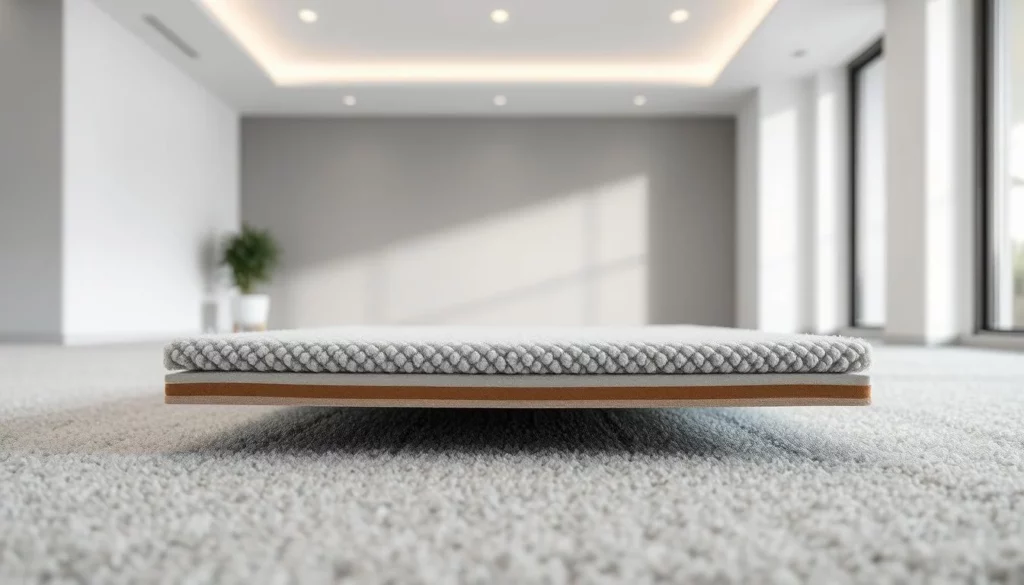
Foam Underlayment Benefits
Foam underlayment is great for soundproofing. It absorbs sound well, like footsteps and other noises. This makes your home quieter.
- Effective noise reduction: Foam underlayment cuts down noise levels in your home.
- Easy installation: It’s simple to put under your carpets and rugs.
- Thermal insulation: It also keeps your home warm in winter and cool in summer.
Cork Underlayment for Enhanced Performance
Cork underlayment is another top choice for soundproofing. It’s known for its great sound absorption and durability. Cork underlayment has many benefits.
- Superior sound absorption: Cork naturally absorbs sound, making it perfect for soundproofing.
- Durability: Cork underlayment lasts long, even with lots of foot traffic.
- Environmental benefits: Cork is eco-friendly and sustainable.
When picking a soundproofing underlayment, think about your space’s needs. Both foam and cork underlayments have special benefits. They can improve your carpets and rugs’ soundproofing.
Placement Strategies for Maximum Soundproofing
The way you place your carpets and rugs can greatly affect a room’s sound quality. To soundproof well, you need to place them in a way that cuts down on echoes and reverberation.
Room Layout Considerations
Think about how sound moves when you plan your room’s layout. Sound absorbing rugs work best in places where sound bounces a lot, like hallways and big rooms. For example, a rug in a hallway can lessen the echo that hallways often have.
Furniture Arrangement Tips
How you set up your furniture is also important for soundproofing. Arranging furniture to fill in open spaces can help cut down on echo and improve sound. Using a mix of sofas, chairs, and bookshelves can make the sound better. Also, putting acoustic carpet padding under your rugs can make them better at absorbing sound.
Choosing the right size and shape for your rugs is key. Bigger rugs that cover more area are better at soaking up sound. Plus, using rugs with other sound-absorbing materials can make them even more effective.
By thinking about your room’s layout and furniture setup, you can make a space that’s both soundproof and cozy. Placing carpets and rugs wisely, along with using sound-absorbing materials, is essential for this.
Maintenance for Optimal Soundproofing Performance
To keep your carpet and rug soundproofing at its best, regular care is key. Keeping them in good shape not only makes them last longer. It also keeps them effective at blocking out noise.
Effective Vacuuming and Cleaning Techniques
Vacuuming is a must for your carpets and rugs. Choose a vacuum with a soft setting to protect the fibers. For deeper cleaning, a carpet shampooer or a pro cleaner might be needed. Cleaning often keeps your soundproofing materials working well.
Tips for Vacuuming:
- Vacuum in multiple directions to loosen dirt and debris.
- Use the upholstery attachment for area rugs and stairs.
- Avoid using the beater brush on delicate or low-pile carpets.
Managing Wear and Tear
Carpet and rugs can wear out over time, affecting their soundproofing. To avoid this, rotate your area rugs to spread out foot traffic. For busy spots, carpet tiles are a good choice. They can be swapped out as needed.
Strategies for Managing Wear:
| Area | Maintenance Tip | Benefit |
|---|---|---|
| High-Traffic | Use carpet tiles | Easier replacement |
| Low-Traffic | Rotate area rugs | Even wear distribution |
| Stairs | Use a stair runner | Reduces noise and wear |
By following these care tips, your carpet and rug soundproofing will stay effective. This makes your home quieter and more comfortable.
Additional Soundproofing Tips and Techniques
There’s more to soundproofing than just underlay for carpets and acoustic padding. You can make your home quieter by adding sound-absorbing elements. This improves the sound quality in your space.
Soft Furnishings for Noise Reduction
Adding soft furnishings is a smart move for better soundproofing. Upholstered furniture, ottomans, and plush throw blankets can soak up sound. This cuts down on echo and noise.
When picking soft furnishings, go for dense, thick materials. They’re better at catching sound waves.
Utilizing Heavy Drapes and Curtains
Heavy drapes and curtains are great for soundproofing. They’re perfect for rooms with big windows or lots of outside noise. Thick, heavy fabrics can block sound, keeping it in or out of the room.
For the best results, use soundproofing drapes or curtains. Or, layer your current curtains with sound-absorbing materials.
| Soundproofing Element | Description | Effectiveness |
|---|---|---|
| Soft Furnishings | Upholstered furniture, ottomans, throw blankets | High |
| Heavy Drapes/Curtains | Thick, heavy fabrics for windows | High |
| Soundproof Underlay | Underlayment for carpets and rugs | Very High |
Using different soundproofing methods together can make a big difference. For example, sound-absorbing rugs with soft furnishings and heavy drapes can greatly reduce noise. It’s all about layering soundproofing elements for the best results.
Cost Considerations for Carpet and Rug Soundproofing
The cost of soundproofing with carpets and rugs depends on several factors. These include the type of carpet or rug, the underlayment options, and the area size.
When planning your soundproofing project, think about the initial costs. These costs include the carpet or rug price and any underlayment materials. For example, carpet insulation for noise reduction can vary in cost based on the underlayment type.
Budgeting for Your Project
To budget for your soundproofing project, consider these key elements:
- The carpet or rug cost, which changes based on material, quality, and brand.
- The underlayment type, as different materials offer different soundproofing levels.
- Installation costs, if you choose to hire a professional.
Here’s a simple cost breakdown for carpet soundproofing:
| Component | Cost Range |
|---|---|
| Carpet/Rug | $1 – $5 per sq. ft. |
| Underlayment | $0.50 – $2 per sq. ft. |
| Installation | $1 – $3 per sq. ft. |
Evaluating Long-Term Value
Initial costs are important, but so is the long-term value of your soundproofing. High-quality carpets and rugs, with the right underlayment, offer lasting soundproofing. This might mean you won’t need to replace them or add more soundproofing later.
Effective soundproofing also improves your living or working space. It reduces noise pollution, making your environment better. Think about the materials’ durability, maintenance needs, and how they make your space quieter and more comfortable.
By looking at both initial costs and long-term benefits, you can make smart choices for your soundproofing project. This ensures it fits your needs and budget.
Professional Installation versus DIY
When it comes to soundproofing with carpets and rugs, you have two main choices. You can hire a professional or do it yourself. Each option has its own pros and cons. The best choice for you depends on your soundproofing needs and budget.
Expertise Matters
If your soundproofing project is complex or you want sure results, go for a professional. They can evaluate your space and suggest the best noise reduction solutions. This includes sound absorbing rugs.
DIY Soundproofing Strategies
For simpler projects or if you’re on a tight budget, DIY soundproofing is a good option. Start by placing sound absorbing rugs in busy areas or rooms with hard floors. You can also use DIY underlayment like foam or cork to boost your carpets and rugs’ soundproofing.
